What is all the fuss about cornering? They are fun, if you know how to do it. We will cover some of the right, not so right, and definitely wrong ways to get through that corner or curve.
The old number one cause of motorcycle incidents (Notice I didn't say accident; you can't prevent an accident.) was the car turning left in front of you. Today the leading cause of motorcycle incidents is running wide in turns. This is one area where the rider is in complete control of his own fate and cannot rely on the other fellow (You know him, the one that causes you to crash.) to get it right or not hurt you.
The Motorcycle Safety Foundation (MSF) recommended credo of slow, look, lean, and roll is, and shall always be, the way to get through that corner or set of curves. Let's break down the individual components:
Slow to entry speed. During your approach to the fun part of the road you should calculate what the correct entry speed of that curve or set of curves is. You may ask, "What is a correct entry speed?" The correct entry speed is that speed which allows you to gradually roll on the throttle throughout the curve. Notice I said, "gradually roll on." If you can grab a whole handful of throttle, your entry speed was slow for that curve. To quote Keith Code, "A two to five mph gain is all you want to get." If your entry speed is correct (at least for the track) and you get more that a five mph gain, you will probably leave the paved surface, and conversely, who wants to slow down more than is necessary?
Where do you look? Look all the way through the curve to the exit point. By looking well ahead, keeping your eyes level with the horizon, you stand the best chance of cutting the curve with one arch instead of several corners. The goal is to make only one steering input, and good visual directional control is the key to smooth cornering. A new rider once asked me if I looked at the edge or centerline when I went through a turn. My response was, "Neither, I'm looking to the next curve to evaluate my best choice for the road ahead. It is already too late to change anything for the curve you are in. Everything you have done prior to starting the curve will determine the outcome."
There are two schools and techniques to get the bike to lean. One is to counter steer as you were taught in the MSF class, or you could body steer. To counter steer is probably the quickest and most precise method of initiating and controlling lean. It is called counter steering because you point the front wheel in the opposite direction you want to go to get the motorcycle to lean in the direction you want it to go. Since a motorcycle is a single track vehicle, you must lean it to turn it . In other words, press the right handle bar grip to right and the left handle bar grip to go left. The other technique is to body steer. If you are going to try this method the correct way is to press with the foot on the peg of the direction of the turn while pulling with the knee on the other side. This technique was successfully used by Reg Pridmore and is currently being demonstrated by his son Jason. A word of caution with this technique is that the rider has a tendency to pull/push the bike down while keeping the body upright or actually leaning out. This can cause excessive lean angles. Be sure to make a conscious effort to lean with the bike when using this technique. Oddly enough, both techniques cause the front wheel to point in the direction opposite of the lean. In one case you counter steer with the handle bar; in the other you use your lower body strength to counter steer. You choose.
Best answer is from the beginning of a curve when you can see the exit, or when you already know where the exit is, i.e. a closed road course or a very familiar road when you know there is no hidden hazard (Interesting condition, could it be true?). If you cannot see the exit when approaching the curve, get your entry speed lower and maintain a steady throttle throughout curve until exit is in view. This should greatly reduce the tendency to run wide in that turn and gives the greatest chance of avoiding possible hazards. Remember, a gradual roll with only a two-five mph gain is desired. Too much roll can torque steer (pick up and straighten the bike) and send you where you hadn't planned on going.
When should each step be applied? I hope you are looking (scanning) all the time; slow during the approach, look to the exit, the lean and roll are practically simultaneous if you have done everything else right. Also don't get too wild on initiating the lean. That could be a major consumer of traction, and without traction you travel in a straight line instead of around the curve.
Turns at speed vs. slow tight turns still use the same steps of slow, look, lean and roll. It is just at speed you lean with or more than the bike and counter steer, and on slow turns be sure to look all the way around and counter weight the bike by shifting to the outside or shifting your weight to the outside peg to balance the weight of yourself and your bike over the contact patches of your tires. At low speed, if you feel the bike starts to drop in, just crack open a little throttle. That engine is stronger than you are and will pick the bike right up. Besides, if the engine isn't stronger than you, you might as well have a bike with pedals and save the gas money.
Next comes the question, should I lean with, out, in? You should lean out only at slow speed to counter weight the bike. In general, leaning with works most of the time. Leaning in will increase the effective lean of the bike. In other words, it acts as if it is leaned over farther than it actually is. This technique improves ground (cornering) clearance for any given speed vs. just leaning with the bike.
Apex, what's all the hype in the magazines? You read and hear a lot about them: take late ones, take early ones. But just what is an apex? The apex of the curve is that point in your path of travel closest to the inside edge of that curve.
Apex selection is part of determining your path of travel. By selecting the proper apex, and using the outside/inside (to apex) and back to outside path of travel, you effectively increase the radius of that curve. The larger the radius of a curve, the less lean is required at a given speed, and conversely, the greater the speed that can be carried through that curve. As an example, and don't hold me to these numbers, they are strictly to illustrate the point, let's say you are going through a curve with a radius 100 ft at 30 mph. The lean angle required is 40 degrees from vertical. But if you take a curve with a radius of 200 ft at the same speed, your lean angle is only 15 degrees from vertical. This also equates to: if your path of travel is the same, and you increase speed, greater lean is required. A great advantage of motorcycles as moto vehicles is that we don't occupy the entire lane in the road, so we can use its entire width to carve a path of travel with the greatest radius, or we can straighten out the curve.
When should you use an early, middle, or late apex? For increasing radius, constant radius, and decreasing radius/limited visibility curves-in that order. When a curve's radius increases, the early apex works because the road straightens out as the radius increases. The constant radius curve is increased the most (remember changing the radius of the curve) by selecting a middle apex. When you have a decreasing radius or a curve with limited sight distance, stay wide as long as possible. This way you have the most visibility around the turn as well as a better path of travel for when the road gets tighter. Remember, if you encounter several constant radius curves together (a mix of left and rights), don't choose the middle apex for the first or any of a curve set. Selecting the middle apex puts you in a bad position to enter the next curve. Selection of a middle apex puts you in a position to run wide in the next curve. For multiple curve sets, choose the late apex. It will put you in the best position for the next turn.
When you ride a motorcycle, traction is what allows you to maintain control. If you have ever taken a MSF Experienced Rider Course, you have seen the Traction Pie. There are three consumers of traction: driving force, side force and braking force. Any one of these consumers has sufficient appetite to consume the whole pie. When the traction is consumed, gravity and inertia of motion in a straight line win. Cornering uses a great deal of side force, which is what gets you through the curve. So if you are using a lot of side force, you don't want to brake or roll on the throttle too much, and you definitely don't roll off the throttle. Rolling off not only reduces ground clearance, it has the same effect as braking. It will destabilize the bike and consume traction as braking force. You only have so much traction, so use what you have wisely.
In most cases traction is pretty much consistent for flat and banked turns. Off camber turns, however, give you two extra considerations. First, your ground clearance is reduced, and second, the available traction is less due to the extra consumption of side force to keep the bike upright on the surface. Remember, side force is used even when going straight, that is what keeps you going in a straight line.
You might ask, "A are straight roads good for anything?" To quote Keith Code, "They get you to the next curve!!"
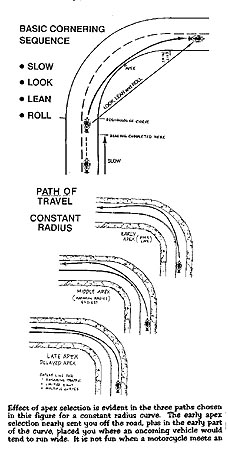
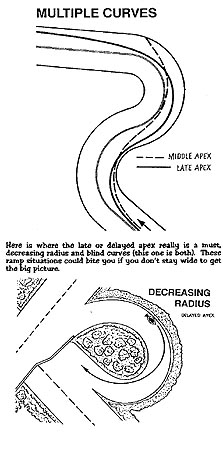
Slow look lean and roll, no matter the corner, that's the technique to use. The following illustration gives general guides on the cornering sequence. As with painting or doing auto body work, if the preparation is good, the finish coat is beautiful. By preparing well for the corner, adjusting to entry speed, looking well through the curve to select your apex and exit point, and providing a gentle roll on, the finished product is a thing of beauty.
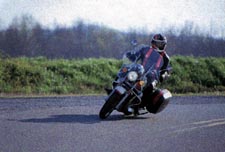
Effect of apex selection is evident in the three paths chosen in this figure for a constant radius curve. The early apex selection nearly sent you off the road, plus in the early part of the curve, placed you where an oncoming vehicle would tend to run wide. It is not fun when a motorcycle meets an object of greater mass. The middle apex selection works well for the constant radius turn. It is a good choice for may riding situations. Now if there is a potential for oncoming traffic, which tends to run wide on their exit, late apex selection works well. By selecting the late apex, you stay wide earlier, staying away from the opposite traffic flow, plus by staying wide longer, you will be able to see further through the curve to detect other possible hazards.
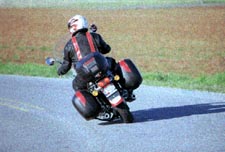
Multiple curves present a different problem. If you take the middle apex for the first curve (the dashed line path) you will end up in a poor position to negotiate the second curve. By taking the middle apex, you were forced to take an early apex for the second, early apex selection will send you wide on all but increasing radius curves. By selecting a late apex for the first curve (the solid line) you are placed in a better position to negotiate the second curve. When riding multiple curves, take the path that sets you up for the next one.
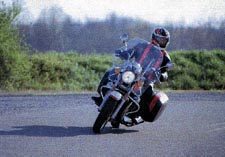
Here is where the late or delayed apex really is a must, decreasing radius and blind curves (this one is both). These ramp situations could bite you if you don't stay wide to get the big picture.
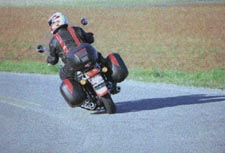
Lean in with or out; the following series of photos illustrate the effect of each.
The same curve was taken at approximately 30 mph for each set of photos. That way, only lean angle required change based on the technique used.
Leaning out will cause the motorcycle to lean more than necessary to make the curve. You can see that there is very little clearance between the saddlebag and the road.
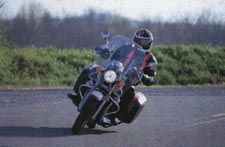
Leaning with the bike works well at moderate speeds. When comparing the clearance you can see there is more available with this technique because less lean is required. By leaning less, less traction goes to side force and the traction reserve is larger. This technique would also allow you to take the same curve at higher speed with the same lean angle shown in the leaning out photos.
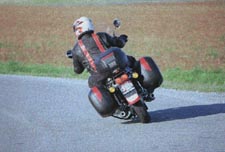
Leaning in reduces the motorcycle's lean angle even more, increasing the traction reserve. Also, you could take the curve at a much higher speed with sufficient clearance available and enough traction reserve.
So now how do you get better at negotiating curves? Start with some training. The Motorcycle Safety Foundation can be contacted for the course available nearest you. To really get the practice, contact California Superbike School, or CLASS for training at speed on a nearby race course.
Motorcycle Safety Foundation: http://msf-usa.org or Call 800-446-9227
California Superbike School: http://www.superbikeschool.com or Call 818-841-7661, FAX 818-841-7019, or write
P.O. Box 3601
Glendale, CA 91221
CLASS: http://www.classrides.com or Call 805-933-9936 or write
CLASS MOTORCYCLE SCHOOLS
320 E. Santa Maria Street, Suite M
Santa Paula, CA 93060-3800